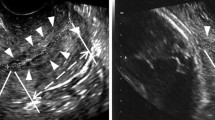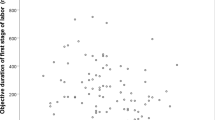Abstract
Purpose
To determine the predisposing changes in cervical length (CL) and the critical range of CL in which significant uterine contractions emerge resulting in threatened preterm labor (TPL).
Methods
Sixty-eight uncomplicated singleton pregnancies where the CL was <25 mm before 31 weeks were divided into cases with TPL (n = 23) or without (n = 45). CL and uterine contractions were monitored sequentially starting between 16 and 20 weeks. The gestational ages when a CL of <25 or <15 mm was first observed, the interval between these two measurements, and the CL value at TPL diagnosis were analyzed retrospectively.
Results
(1) The gestational ages when a CL of <25 and <15 mm was first detected were lower in the TPL group (25 (median); 18–30 (range) and 28; 25–33 weeks, respectively) than in the non-TPL group (27; 20–30 and 33; 26–35 weeks; P = 0.030 and P < 0.001). (2) The interval between the two measurements was shorter in the TPL group (2.5; 0–15 weeks) than in the non-TPL group (5.5; 0–13 weeks, P = 0.034). (3) The CL value at TPL diagnosis was 13 mm (median), ranging from 7 to 18 mm.
Conclusion
Cases with early onset and subsequent rapid CL shortening before 31 weeks resulted in TPL when CL decreased below the range 7–18 mm.


Similar content being viewed by others
References
Andrews WW, Copper R, Hauth JC, Goldenberg RL, Neely C, Dubard M. Second-trimester cervical ultrasound: associations with increased risk for recurrent early spontaneous delivery. Obstet Gynecol. 2000;95:222–6.
Cook CM, Ellwood DA. The cervix as a predictor of preterm delivery in ‘at-risk’ women. Ultrasound Obstet Gynecol. 2000;15:109–13.
Heath VCF, Southall TR, Souka AP, Elisseou A, Nicolaides KH. Cervical length at 23 weeks of gestation: prediction of spontaneous preterm delivery. Ultrasound Obstet Gynecol. 1998;12:312–7.
Owen J, Yost N, Berghella V, et al. Can shortened midtrimester cervical length predict very early spontaneous preterm birth? Am J Obstet Gynecol. 2004;191:298–303.
Taipale P, Hiilesmaa V. Sonographic measurement of uterine cervix at 18–22 weeks’ gestation and the risk of preterm delivery. Obstet Gynecol. 1998;92:902–7.
Tsoi E, Akmal S, Rane S, Otigbah C, Nicolaides KH. Ultrasound assessment of cervical length in threatened preterm labor. Ultrasound Obstet Gynecol. 2003;21:552–5.
Fuchs IB, Henrich W, Osthues K, Dudenhausen JW. Sonographic cervical length in singleton pregnancies with intact membranes presenting with threatened preterm labor. Ultrasound Obstet Gynecol. 2004;24:554–7.
Palacio M, Sanin-Blair J, Sanchez M, et al. The use of a variable cut-off value of cervical length in women admitted for preterm labor before and after 32 weeks. Ultrasound Obstet Gynecol. 2007;29:421–6.
Schmitz T, Kayem G, Maillard F, Lebret MT, Cabrol D, Goffinet F. Selective use of sonographic cervical length measurement for predicting imminent preterm delivery in women with preterm labor and intact membranes. Ultrasound Obstet Gynecol. 2008;31:421–6.
Berghella VB, Iams JD, Newman RB, MacPherson C, Goldberg RL, Mueller-Heubach E, et al. Frequency of uterine contractions in asymptomatic pregnant women with or without a short cervix on transvaginal ultrasound scan. Am J Obstet Gynecol. 2004;191:1253–6.
Cook CM, Ellwood DA. Is there a relationship between uterine activity and the length of the cervix in the second trimester? J Obstet Gynaecol Res. 2000;26:347–50.
Yoshizato T, Obama H, Nojiri T, Miyake Y, Miyamoto S, Kawarabayashi T. Clinical significance of cervical length shortening before 31 weeks’ gestation assessed by longitudinal observation using transvaginal ultrasonography. J Obstet Gynaecol Res. 2008;34:805–11.
Gramellini D, Fieni S, Molina F, Berretta R, Vadora E. Transvaginal sonographic cervical length changes during normal pregnancy. J Ultrasound Med. 2002;21:227–32.
Gomez R, Romero R, Nien JK, Chaiworapongsa T, Medina L, Kim YM, et al. A short cervix in women with preterm labor and intact membranes: a risk for microbial invasion of the amniotic cavity. Am J Obstet Gynecol. 2005;192:678–89.
Holst RM, Jacobsson B, Hagberg H, Wennerholm UB. Cervical length in women in preterm labor with intact membranes: relationship to intra-amniotic inflammation/microbial invasion, cervical inflammation and preterm delivery. Ultrasound Obstet Gynecol. 2006;28:768–74.
Acknowledgments
This study was supported in part by the Ogya Foundation, Japan.
Author information
Authors and Affiliations
Corresponding author
About this article
Cite this article
Yoshizato, T., Tsujioka, H., Horiuchi, S. et al. Change in cervical length in cases resulting in threatened preterm labor. J Med Ultrasonics 37, 195–200 (2010). https://doi.org/10.1007/s10396-010-0279-2
Received:
Accepted:
Published:
Issue Date:
DOI: https://doi.org/10.1007/s10396-010-0279-2




